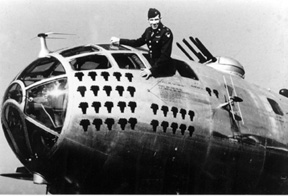|
RB-29 Crew Hist. - Hiking Rural Japan - Extended Stories - Short Stories Biographical Notes - Current Commentary - Art Gallery - Fun Stuff - Education Programs - Locator- Reunions - Memorials - Cold War Museum Web Site 31/91st Recollections of Adrian Swain, RB-29 Pilot Page 2 of 4 Pages |
||||||||
|
Warm, dry days arrived in the spring of 1950, and our squadron baseball players began limbering up for opening day with daily workouts on the diamond. I had missed the games last season and wanted badly to participate this year. Housemates Brunson and Snow helped me practice at home after work, playing pitch and catch in front of our Quonset. Within a few weeks, I began to gain ball speed and control. The fast ball was coming along, and I was working on a sweeping curve that would come over the plate and then drop downward six to eight inches — it was a devastating pitch. By early April, we began competition and I was one of three pitchers. By mid-May, I was in a groove and pitched the most memorable game of my life one afternoon, striking out fifteen batters. They could not cope with the dropping curve ball, even when they knew it was coming. I was stiff and sore after the game, but a hot shower before going to the Officer’s Club to bask in the kudos of my mates made it all worthwhile. I did not know that this was the last game I would ever pitch. |
||||||||
 |
||||||||
| The next day our crew was called into operations and briefed on a special mission to Tokyo; this was no shopping trip to the Ginza. Colonel Edwards was there and complimented me on my good game before getting down to business. We had been selected for a special temporary assignment that was so restricted we would receive full details only when we got to Japan. |
||||||||
|
|
||||||||
| The next day we were briefed at the Air Force base at Chitose on Hokkaido Island, the northernmost of the Japanese Islands and just south of the Russian-owned Kuril Islands. Intelligence reports advised that the Russians were significantly increasing their military strength at their forward air base on Sakhalin Island. Our job was to take aerial photos of the suspect airfield and not get caught. There were MIG fighter aircraft at the base, which worried us somewhat. The course we were to fly was designed to imitate a Northwest Airlines flight enroute to Alaska, a flight that might have drifted off course. Hopefully we would appear to be committing a harmless violation of their costal waters.
Our crew was confined to base for the next three days, waiting for weather and heavy clouds to clear the area. Knowing that the cold war between the Russian Bear and the American Eagle was beginning to heat up did not make us feel too comfortable. If the Russians sent up MIG fighters, they would have every right to force us to land. We had a 50-50 chance of pulling it off unchallenged, because we would not be more than one hundred and fifty miles off the usual airliner flight path. It could be explained as a navigation error if we were caught. Finally, the weather cleared, and we roared off the runway, Earl Myers in the left seat and me in the right. We leveled off at about 25,000 feet (normal airline altitude), sandwiched between two layers of gray status clouds. The weather improved as we approached the target area. Just opposite Sakhalin, still beyond the 12-mile statutory limit usually respected by international law, we applied more power, increasing our airspeed and turned toward our target. We began a wide sweeping turn, hoping it would show on the Russian radar that we were turning back on course. At the same time, our turn permitted our K-18 and K-20 wide-angle camers plenty of opportunity to take photos of the suspect airfield below. As we made our camera run, the ship’s intercom was filled with tense comment as two imaginary sightings of enemy aircraft were reported. The cloud cover was a problem for our camera people and a threat to us, for who knew how many MIGs might be hidden there. We were committed, however, and our cameras continued to roll. Luckily, no MIGs appeared, and for the next five minutes we sweated it out as our ship slowly turned east. Earl then put the nose down to pick up airspeed, and with our cameras off we headed toward Japan, the risk of becoming an international incident diminishing with every turn of our propellers. Six months later, I was advised by our intelligence people that nothing unusual had been discovered by the photos we took that day. All the film was destroyed and not a word was mentioned of our flight, except perhaps in this writing. Page 2 of 4 Pages — Go to Page 3 Home - Contact Us - Cold War Hist. - 91st SRS Hist. - Stardust 40 Mission Story |
||||||||